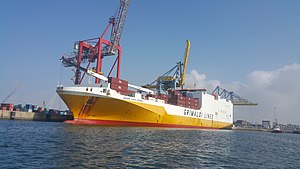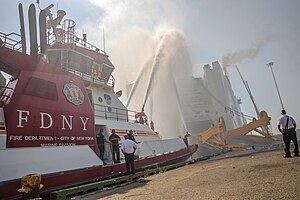Grande Costa D’Avorio: Difference between revisions
George Swan (talk | contribs) (copy editing) |
Pat Palmer (talk | contribs) (trying to resolve ref error) |
||
| (One intermediate revision by the same user not shown) | |||
| Line 2: | Line 2: | ||
[[File:Car_carrier_GRANDE_COSTA_D%27AVORIO_au_port.jpg | thumb | The ''Grande Costa D’Avorio'' in [[Casablanca, Morocco]], in 2018.]] | [[File:Car_carrier_GRANDE_COSTA_D%27AVORIO_au_port.jpg | thumb | The ''Grande Costa D’Avorio'' in [[Casablanca, Morocco]], in 2018.]] | ||
[[File:Grande Costa D’Avorio fire 2023 Port Newark 2.jpg | thumb | [[Fireboats of New York City|Fireboats from New York City]] came to assistance of the [[Newark Fire Department]] because [[Fireboats in New Jersey|Newark's fireboats]] were not in working order.]] | [[File:Grande Costa D’Avorio fire 2023 Port Newark 2.jpg | thumb | [[Fireboats of New York City|Fireboats from New York City]] came to assistance of the [[Newark Fire Department]] because [[Fireboats in New Jersey|Newark's fireboats]] were not in working order.]] | ||
The '''''Grande Costa D’Avorio''''' is an [[Italian]] [[freighter]]. She was built to simultaneously carry a deck cargo of [[Intermodal container]] and an internal cargo of [[automobile]]s or other road vehicles. She was launched in 2011. She survived a catastrophic fire, in [[Newark, New Jersey]], on July 5, 2023. | The '''''Grande Costa D’Avorio''''' is an [[Italian]] [[freighter]]. She was built to simultaneously carry a deck cargo of [[Intermodal container]] and an internal cargo of [[automobile]]s or other road vehicles. She was launched in 2011. She survived a catastrophic fire, in [[Newark, New Jersey]], on July 5, 2023.<ref name=Nj2024-01-17/><ref name=professionalmarinerNewAllegations/> | ||
The vessel is owned by the [[Grimaldi Group]], [[Italy]]'s largest shipping firm.<ref name=nytimes2023-07-06/> | The vessel is owned by the [[Grimaldi Group]], [[Italy]]'s largest shipping firm.<ref name=nytimes2023-07-06/> | ||
| Line 8: | Line 8: | ||
The [[United States Coast Guard|US Coast Guard]] reported it took five days to finally extinguish the fire.<ref name=professionalmarinerNewAllegations/> Commentators described how, with a fire this hot, firefighters could not fight the fire directly, and the best approach was to keep the vessel under a constant bombardment of water, in an attempt to cool the blaze. Firefighters directed so much water to the vessel it developed a list, and pumps had to be deployed to pump out that water. | The [[United States Coast Guard|US Coast Guard]] reported it took five days to finally extinguish the fire.<ref name=professionalmarinerNewAllegations/> Commentators described how, with a fire this hot, firefighters could not fight the fire directly, and the best approach was to keep the vessel under a constant bombardment of water, in an attempt to cool the blaze. Firefighters directed so much water to the vessel it developed a list, and pumps had to be deployed to pump out that water. | ||
Initial reports stated the vessel's crew had deployed its fire-suppression system prior to the arrival of Newark firefighters.<ref name=professionalmarinerNewAllegations/> However, after an official inquiry, accident investigators concluded the vessel's crew did not know how to properly use the fire-suppression system. | Initial reports stated the vessel's crew had deployed its fire-suppression system prior to the arrival of Newark firefighters.<ref name=professionalmarinerNewAllegations/> However, after an official inquiry, accident investigators concluded the vessel's crew did not know how to properly use the fire-suppression system. | ||
Investigators determined that the fire aboard the vessel was started by [[stevedore]]s use of an improperly maintained [[Jeep]] they were using to push a vehicle they were loading. | Investigators determined that the fire aboard the vessel was started by [[stevedore]]s use of an improperly maintained [[Jeep]] they were using to push a vehicle they were loading. The Jeep was known to have a problem with over-heating, and the Jeep burst in to flame on the day of the fire. | ||
Newark firefighters found the ''Grande Costa D'Avorio''{{'}}s fire-suppression system was not equipped with fittings for their {{convert|2.5|inch|cm}} firehoses.<ref name=nytimes2023-07-06/> They were forced to use the vessel's much less powerful {{convert|1|inch|cm}} firehoses. | Newark firefighters found the ''Grande Costa D'Avorio''{{'}}s fire-suppression system was not equipped with fittings for their {{convert|2.5|inch|cm}} firehoses.<ref name=nytimes2023-07-06/> They were forced to use the vessel's much less powerful {{convert|1|inch|cm}} firehoses. | ||
Since neither of [[Fireboats in New Jersey|Newark's fireboats]] was working on the day of the fire Newark firefighter boarded the vessel to fight the fire. Two of the Newark Fire Department's fire captains, [[Wayne Brooks Jr.]] and [[Augusto Acabou]], died after boarding the freighter.<ref name=Nj2024-01-17/> Another five fire fighters were wounded. [[Fireboats of New York City|Fireboats from New York City]] came to assistance on their own initiative, to fight the fire. | Since neither of [[Fireboats in New Jersey|Newark's fireboats]] was working on the day of the fire Newark firefighter boarded the vessel to fight the fire. Two of the Newark Fire Department's fire captains, [[Wayne Brooks Jr.]] and [[Augusto Acabou]], died after boarding the freighter.<ref name=Nj2024-01-17/> Another five fire fighters were wounded. [[Fireboats of New York City|Fireboats from New York City]] came to assistance on their own initiative, to fight the fire. No official request had been made. It was New York City firefighters who located the bodies of the Newark firefighters. | ||
Vehicles carried by roll-on roll-off vessels are usually driven on-board and off-board under their own power, and it was the gasoline the vehicles were powered by that provided the fuel for the blaze.<ref name=nytimes2023-07-06/> | Vehicles carried by roll-on roll-off vessels are usually driven on-board and off-board under their own power, and it was the gasoline the vehicles were powered by that provided the fuel for the blaze.<ref name=nytimes2023-07-06/> | ||
| Line 55: | Line 55: | ||
| url-status = live | | url-status = live | ||
| quote = Firefighters who raced to the scene from Engine 16 quickly learned that their standard, 2.5-inch hose lines would not connect to the equipment on the European-built ship, the Grande Costa d’Avorio. They were forced to use the vessel’s one-inch firefighting hoses, Newark’s mayor, Ras J. Baraka, would later explain. | | quote = Firefighters who raced to the scene from Engine 16 quickly learned that their standard, 2.5-inch hose lines would not connect to the equipment on the European-built ship, the Grande Costa d’Avorio. They were forced to use the vessel’s one-inch firefighting hoses, Newark’s mayor, Ras J. Baraka, would later explain. | ||
}} | }} | ||
</ref> | </ref> | ||
Latest revision as of 09:19, 26 August 2024


The Grande Costa D’Avorio is an Italian freighter. She was built to simultaneously carry a deck cargo of Intermodal container and an internal cargo of automobiles or other road vehicles. She was launched in 2011. She survived a catastrophic fire, in Newark, New Jersey, on July 5, 2023.[1][2]
The vessel is owned by the Grimaldi Group, Italy's largest shipping firm.[3]
The US Coast Guard reported it took five days to finally extinguish the fire.[2] Commentators described how, with a fire this hot, firefighters could not fight the fire directly, and the best approach was to keep the vessel under a constant bombardment of water, in an attempt to cool the blaze. Firefighters directed so much water to the vessel it developed a list, and pumps had to be deployed to pump out that water.
Initial reports stated the vessel's crew had deployed its fire-suppression system prior to the arrival of Newark firefighters.[2] However, after an official inquiry, accident investigators concluded the vessel's crew did not know how to properly use the fire-suppression system.
Investigators determined that the fire aboard the vessel was started by stevedores use of an improperly maintained Jeep they were using to push a vehicle they were loading. The Jeep was known to have a problem with over-heating, and the Jeep burst in to flame on the day of the fire.
Newark firefighters found the Grande Costa D'Avorio's fire-suppression system was not equipped with fittings for their 2.5 inch (6.35 cm) firehoses.[3] They were forced to use the vessel's much less powerful 1 inch (2.54 cm) firehoses.
Since neither of Newark's fireboats was working on the day of the fire Newark firefighter boarded the vessel to fight the fire. Two of the Newark Fire Department's fire captains, Wayne Brooks Jr. and Augusto Acabou, died after boarding the freighter.[1] Another five fire fighters were wounded. Fireboats from New York City came to assistance on their own initiative, to fight the fire. No official request had been made. It was New York City firefighters who located the bodies of the Newark firefighters.
Vehicles carried by roll-on roll-off vessels are usually driven on-board and off-board under their own power, and it was the gasoline the vehicles were powered by that provided the fuel for the blaze.[3]
References
- ↑ 1.0 1.1 ‘Deaths were preventable,’ say anguished family members of 2 firefighters lost in Port Newark fire, NJ.com, 2024-01-17. Retrieved on 2024-01-18.
- ↑ 2.0 2.1 2.2 New allegations regarding cause of Grande Costa d’Avorio fire, Professional Mariner. Retrieved on 2024-01-18. “Five days after the fire broke out, the Coast Guard announced that the fire aboard the Grande Costa d’Avorio was out.”
- ↑ 3.0 3.1 3.2 Tracey Tully, Mike Ives, Elise Young. How 2 Firefighters Died in a Blaze They Were Ill-Equipped to Face, New York Times, 2023-07-06, p. A10. Retrieved on 2024-01-18. “Firefighters who raced to the scene from Engine 16 quickly learned that their standard, 2.5-inch hose lines would not connect to the equipment on the European-built ship, the Grande Costa d’Avorio. They were forced to use the vessel’s one-inch firefighting hoses, Newark’s mayor, Ras J. Baraka, would later explain.”